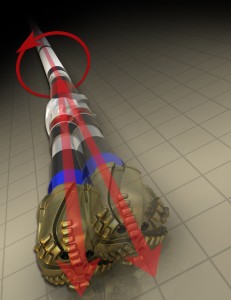New directional drilling system combines improved mud motor, MWD technologies

By Katie Mazerov, contributing editor
Weatherford has launched a directional drilling system aimed at providing an economic alternative to conventional rotary-steerable systems (RSS). The MotarySteerable Directional Control System combines the hydraulic horsepower of a positive displacement mud motor (PDM) and the directional capability of an RSS to provide continuous 3D directional control while rotating, said Chris Maranuk, new-product launch manager.
“Our customers have been asking for years for an economical alternative to RSS,” he said. “This is a unique, low-angle assist tool that has a lot of the features of an RSS in terms of delivering continuous drill pipe rotation with 3D directional-drilling control.” The system incorporates a mud motor with a bent sub and measurement-while-drilling (MWD) tools using a new steering technique called targeted bit speed (TBS).
TBS overcomes one of the key limitations of mud motors – sliding. Sliding requires that the drillstring rotation be stopped while the bit is rotating downhole. The system is flexible in that while it provides low rotating build rates, it can switch from continuous rotation to conventional drilling, or sliding, if higher build rates are required. All of this can be accomplished without making changes to the BHA.
Designed for any application that uses a mud motor, the system is particularly suited for low-cost shale operations. “The economics of the MotarySteerable system versus RSS is a key differentiator,” he said. Highly deviated wells can typically be drilled with a PDM, which provides benefits in terms of cost, reliability and performance over conventional RSS systems. Lost-in-hole costs for the system are much less than for an RSS tool, which is built using complex electro-mechanical components, he explained.
The system has three applications: vertical control; horizontal control and tangential applications where a hole is drilled and held at an angle. “We’ve had very good success in vertical and horizontal situations, and we are developing the system further for the tangential niche,” Mr Maranuk said.

Three Key Metrics
“In developing this system, we capitalized on improvements in both mud motor and MWD tools, technologies that are well-understood by the industry,” he continued. “Both work well separately, but they deliver even better performance when combined. We targeted three key metrics – rate of production (ROP), reduction of time sliding versus rotating time and days on location, reasoning that if this system can reduce sliding, it can increase ROP and reduce days on location.”
The technology was developed in 2008 and 2009 and tested in various hole sizes. In 2010, it was deployed in field trials in the Uintah Basin and the Barnett and Eagle Ford shale plays, successfully drilling more than 50,000 ft of hole in 6-in., 7 7/8-in. and 9 7/8-in. holes. The 7 7/8-in. hole size is common in North America but is infrequently serviced by RSS, Mr Maranuk said.
The system has since been used to drill more than 30 wells totaling over 200,000 ft in both conventional and shale environments in most major US markets and Mexico. It is currently being launched in Poland and Russia.
In one case, the MotarySteerable system was used to drill from 3,691 ft to 8,100 ft in a vertical well in the Eagle Ford shale play. Deployment of the technology in a single run eliminated the majority of sliding and achieved an ROP of 149 ft/hr. The system saved the operator more than $200,000.
In two horizontal wells in the Granite Wash, a well drilled with the MotarySteerable system was measured against a conventionally drilled well. Both wells used PDM; well depths, rig, crew, mud and other key parameters were nearly identical. The MotarySteerable well required strict directional control as it was drilled between two producing wells.
Results showed that for the MotarySteerable well, ROP was 10% higher than the conventional well, overall sliding was reduced and time versus depth drilling curve was cut by two days, according to Weatherford
MotarySteerable is a trademarked term of Weatherford International Ltd.





This new technologies is going to benefit in the process of directional drilling. Thank you for the important post.